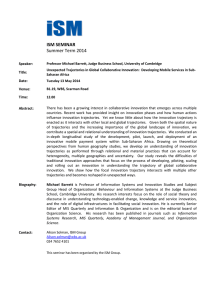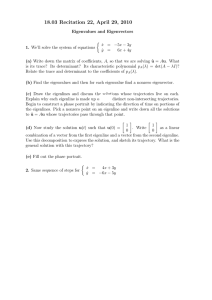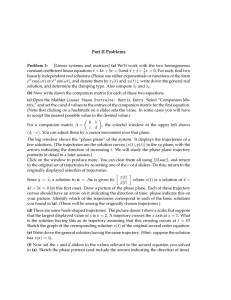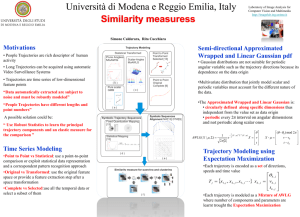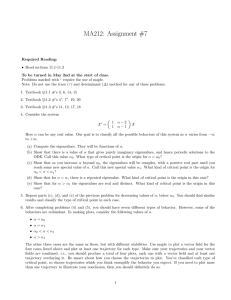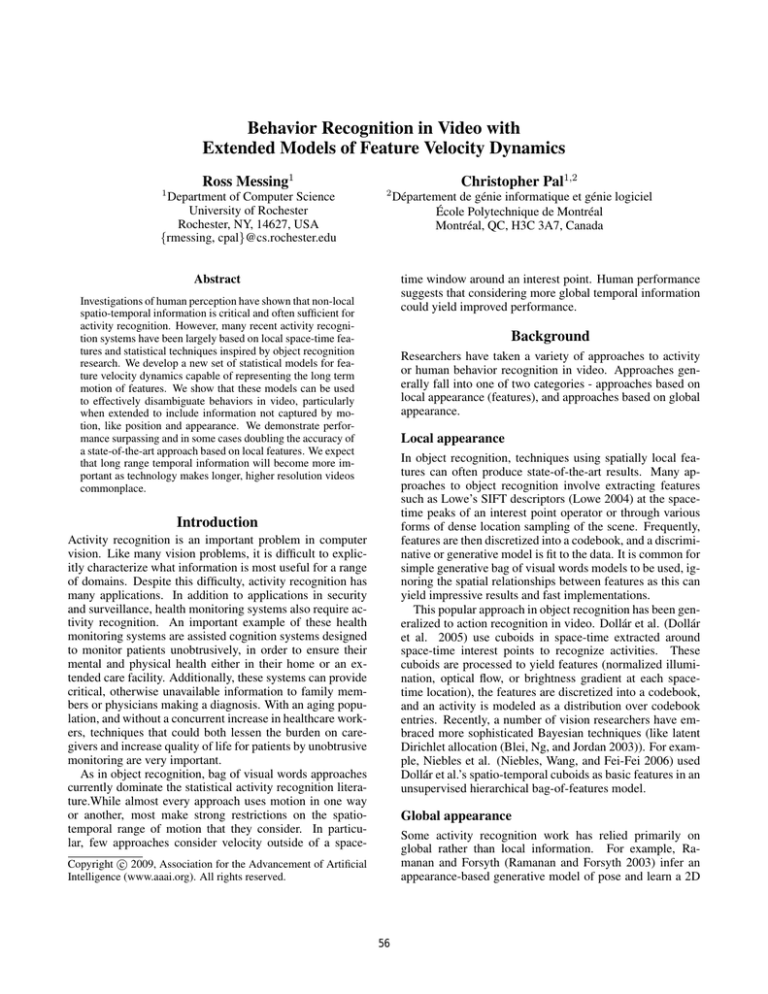
Behavior Recognition in Video with
Extended Models of Feature Velocity Dynamics
1
Ross Messing1
Department of Computer Science
University of Rochester
Rochester, NY, 14627, USA
{rmessing, cpal}@cs.rochester.edu
2
Christopher Pal1,2
Département de génie informatique et génie logiciel
École Polytechnique de Montréal
Montréal, QC, H3C 3A7, Canada
time window around an interest point. Human performance
suggests that considering more global temporal information
could yield improved performance.
Abstract
Investigations of human perception have shown that non-local
spatio-temporal information is critical and often sufficient for
activity recognition. However, many recent activity recognition systems have been largely based on local space-time features and statistical techniques inspired by object recognition
research. We develop a new set of statistical models for feature velocity dynamics capable of representing the long term
motion of features. We show that these models can be used
to effectively disambiguate behaviors in video, particularly
when extended to include information not captured by motion, like position and appearance. We demonstrate performance surpassing and in some cases doubling the accuracy of
a state-of-the-art approach based on local features. We expect
that long range temporal information will become more important as technology makes longer, higher resolution videos
commonplace.
Background
Researchers have taken a variety of approaches to activity
or human behavior recognition in video. Approaches generally fall into one of two categories - approaches based on
local appearance (features), and approaches based on global
appearance.
Local appearance
In object recognition, techniques using spatially local features can often produce state-of-the-art results. Many approaches to object recognition involve extracting features
such as Lowe’s SIFT descriptors (Lowe 2004) at the spacetime peaks of an interest point operator or through various
forms of dense location sampling of the scene. Frequently,
features are then discretized into a codebook, and a discriminative or generative model is fit to the data. It is common for
simple generative bag of visual words models to be used, ignoring the spatial relationships between features as this can
yield impressive results and fast implementations.
This popular approach in object recognition has been generalized to action recognition in video. Dollár et al. (Dollár
et al. 2005) use cuboids in space-time extracted around
space-time interest points to recognize activities. These
cuboids are processed to yield features (normalized illumination, optical flow, or brightness gradient at each spacetime location), the features are discretized into a codebook,
and an activity is modeled as a distribution over codebook
entries. Recently, a number of vision researchers have embraced more sophisticated Bayesian techniques (like latent
Dirichlet allocation (Blei, Ng, and Jordan 2003)). For example, Niebles et al. (Niebles, Wang, and Fei-Fei 2006) used
Dollár et al.’s spatio-temporal cuboids as basic features in an
unsupervised hierarchical bag-of-features model.
Introduction
Activity recognition is an important problem in computer
vision. Like many vision problems, it is difficult to explicitly characterize what information is most useful for a range
of domains. Despite this difficulty, activity recognition has
many applications. In addition to applications in security
and surveillance, health monitoring systems also require activity recognition. An important example of these health
monitoring systems are assisted cognition systems designed
to monitor patients unobtrusively, in order to ensure their
mental and physical health either in their home or an extended care facility. Additionally, these systems can provide
critical, otherwise unavailable information to family members or physicians making a diagnosis. With an aging population, and without a concurrent increase in healthcare workers, techniques that could both lessen the burden on caregivers and increase quality of life for patients by unobtrusive
monitoring are very important.
As in object recognition, bag of visual words approaches
currently dominate the statistical activity recognition literature.While almost every approach uses motion in one way
or another, most make strong restrictions on the spatiotemporal range of motion that they consider. In particular, few approaches consider velocity outside of a space-
Global appearance
Some activity recognition work has relied primarily on
global rather than local information. For example, Ramanan and Forsyth (Ramanan and Forsyth 2003) infer an
appearance-based generative model of pose and learn a 2D
c 2009, Association for the Advancement of Artificial
Copyright Intelligence (www.aaai.org). All rights reserved.
56
modeling based approaches, we seek to determine whether
increasing the quality and quantity of non-local motion information could provide a robust source of information for
activity recognition. As such, we develop a model capable
of using the full velocity history of a tracked feature.
Much of the previous trajectory tracking work has often
been based on object centroid or bounding box trajectories.
In a more sophisticated extension of such approaches, Rosales and Sclaroff (Rosales and Sclaroff 1999) used an extended Kalman filter to help keep track of bounding boxes of
segmented moving objects and then use motion history images and motion energy images as a way of summarizing the
trajectories of tracked objects. Madabhushi and Aggarwal
(Madabhushi and Aggarwal 1999) the trajectories of heads
tracked in video and built models based on the mean and
covariance of velocities. Our approach to analyzing feature
trajectories differs dramatically from these previous methods in that we use dense clouds of KLT (Lucas and Kanade
1981) feature tracks. In this way our underlying feature representation is also much closer to Johansson’s point lights.
to 3D mapping with motion capture training data. A novel
item is compared to clustered training data in 3D-pose space.
This is typical of the highly structured model-based approach to human tracking. While this approach can infer
a great deal of useful information, its primary purpose is
high-level pose modeling. Pose can be helpful in activity
recognition, but motion information can potentially be just
as useful for activity recognition, and these models do not
generally use motion beyond inferring high-level pose.
A few recent activity recognition methods directly generalize local appearance methods to global appearance. For
example, Niebles and Fei-Fei (Niebles and Fei-Fei 2007)
extend Niebles et al.(Niebles, Wang, and Fei-Fei 2006) by
adding a constellation model characterizing the relative spatial layout of ”parts”. In their model, each part is a Bag-ofWords, as in their original work.
Global Motion
While much of the work reviewed so far has revolved around
a combination of local appearance and motion, human activity recognition can be facilitated by global motion perception in the absence of useful appearance information.
Johansson (Johansson 1973) showed that point-light displays of even very complicated, structured motion were perceived easily by human subjects . Most famously, Johansson showed that human subjects could correctly perceive
“point-light walkers”, a motion stimulus generated by a person walking in the dark, with points of light attached to the
walker’s body. This leads us to speculate that motion aloneis
sufficient to recognize activities in the absence of local appearance information. Naturally, most work on video sequences analyzes change over time. One way to do this
is optical flow, which provides a dense measure of change
for every point in the image between every adjacent pair of
frames. Despite the density of optical flow, it can be a shallow feature, conveying a great deal of noise along with a
limited amount of signal. Some way of characterizing motion at particularly interesting points, analogous to the pointlights on Johansson’s walkers, could convey almost as much
signal, with much less noise.
The interest point centered, space-time cubiod features of
Dollár et al.(Dollár et al. 2005) represent a move towards
the point lights of Johnsson; however, there are a number
of differences. The space-time cuboid approach only deals
with local motion that falls fully within the space-time window captured by the feature descriptor and it thus has no
way of dealing with much longer range motion. Savarese
et al. (Savarese et al. 2008) have extended this approach
by adding spatio-temporal correlatons to the bag of features,
which capture the relative positions of features. This approach works well with a bag-of-features model, but fails
to capture the information contained in the extended motion of any particular feature. Madabhushi and Aggarwal
(Madabhushi and Aggarwal 1999) described a system using
the motion trajectory of a single feature, the center of the
head, to distinguish between activities. While the system
had limited success, the ability to use extremely sparse feature motion for activity recognition shows how informative
feature motion can be. In the spirit of this an other trajectory
Position
While feature motion is often informative, and clearly plays
a primary role for humans perceiving activities, it is not perceived in a vacuum even in point-light displays, where the
relative positions of the point-lights are also available to the
viewer. Many extensions to bag-of-features models in vision
focus on weakening the geometric assumptions made by that
model. In addition to Niebles and Fei-Fei’s hierarchical constellation model(Niebles and Fei-Fei 2007), and Wong et
al.’s extended topic model (Wong, Kim, and Cipolla 2007),
other vision work outside of activity recognition has used
this approach to add spatial structure to a model that originally had none. The best known example of this might be
Fergus et al.’s constellation model (Fergus, Perona, and Zisserman 2003) for object recognition. Clearly, augmenting a
feature with position provides a powerful, tractable way to
incorporate position into a bag-of-features approach.
Appearance
In addition to position, appearance information can be extremely useful in disambiguating activities. While human
subjects can recognize actions performed by Johansson’s
point-light walkers (Johansson 1973), it is even easier to
identify activities when shown unrestricted videos. Local
appearance patches have become the dominant approach to
object recognition, and direct extensions of these approaches
based on local space-time patches make up a large part of the
statistical activity recognition literature.
Activities to Recognize
Activity recognition has no accepted standard dataset. It
is difficult to compare the performance of systems meant
to solve the same, or similar tasks. This is particularly
troublesome because many researchers generate their own
datasets, and it is not always clear what assumptions went
into their generation. The most popular activity recognition dataset is the KTH dataset (Schuldt, Laptev, and Caputo
57
2004), used by a number of systems (Dollár et al. 2005;
Wong, Kim, and Cipolla 2007; Savarese et al. 2008;
Niebles, Wang, and Fei-Fei 2006). This dataset consists
of low-resolution (160 × 120 pixels) video clips taken by a
non-moving camera of 25 subjects performing each of 6 actions (walking, clapping, boxing, waving, jogging and running) in several background-variation conditions. While this
dataset has an appealingly large amount of data for each activity, it is not really suitable to test an assisted cognition
system. First, there is a lot of variation in the background between video sequences, while we can assume an almost constant background in an assisted cognition context. Second,
the background in the KTH dataset is uninformative, while
background can provide a great deal of contextual information for activity an assisted cognition task. In addition, the
dataset consists largely of full-body activities that involve
no objects, while object interaction can provide a valuable
source of information for the kind of activities of daily living
that an assisted cognition system must deal with. Lastly, the
low resolution of this dataset may compromise the quality of
the feature trajectories extracted, both in velocity resolution,
and track duration.
In order to evaluate an activity recognition system for
an assisted cognition task, we construct a new dataset to
overcome the shortcomings we have identified in the KTH
dataset.
Figure 1: Example trajectories from the following activities
(from left to right): eating a banana, dialing a phone, drinking water, answering the phone and chopping a banana
Figure 2: A background im- Figure 3:
Codebookage from the activities of generated pixel map of
daily living data set
birth-death locations
features the tracker could find. We call each feature’s quantized velocity over time its “Feature Trajectories”, and use
this as our basic feature. We emphasize that we are unaware
of other work on activity recognition using a motion description with as long a temporal range as the technique presented
here. Uniform quantization is done in log-polar coordinates,
with 8 bins for direction, and 5 for magnitude. The video
was captured at 30 frames per second, and its initial temporal resolution was maintained. We limited the velocity magnitude to 10 pixels per frame, which in our high-resolution
dataset corresponds almost exclusively to noise. This limit
meant that for an individual feature’s motion from one frame
to the next, any motion above the threshold was not ignored,
but that feature’s motion on that frame was placed in the bin
for the greatest motion magnitude in the appropriate direction. We also only considered feature trajectories lasting at
least a third of a second. This heuristic reduces noise while
eliminating little of the extended velocity information we
seek to capture. Examples of the trajectories being extracted
can be seen in Figure 1.
A Model of Feature Velocity Dynamics and
Extensions
We present a system that extracts a set of feature trajectories
from a video sequence, augments them with information unrelated to motion, and uses a model of how those trajectories
were generated to classify the trajectory sets.
Method
Flow extraction Given a video sequence, we extract feature trajectories using Birchfield’s implementation (Birchfield 1996) of the KLT tracker (Lucas and Kanade 1981).
This system finds interest points where both eigenvalues of
the matrix of the image gradients are greater than a threshold, and tracks them by calculating frame-to-frame translation with an affine consistency check. In order to maximize
the duration of our feature trajectories, and thus capitalize
on their descriptive power, we did not use the affine consistency check (which ensures that the features have not deformed). This increased the amount of noise in the feature
trajectories, but also the ability to capture non-rigid motion.
As described by Baker and Matthews (Baker and Matthews
2004), the tracker finds the match that minimizes
[W (x; p) − T (x)]2
(1)
Feature Augmentations Features were augmented by location information indicating their initial and final positions
(their “birth” and “death” positions). To obtain a given feature trajectory’s birth and death, we use k-means clustering
(k = 24)to form a codebook for both birth and death (independently), and assign a feature’s birth and death to be it’s
nearest neighbor in the codebook. The results of this codebook can be seen in Figure 3, which was generated from
activities in the scene shown in Figure 2.
In addition to this absolute position information, features
are also augmented by relative position information. We use
birth and death positions of the feature relative to the position of an unambiguously detected face, if present. Like
birth and death, these positions are clustered by k-means
(k = 100) into a codebook, and a feature position relative
to the face is assigned to it’s nearest neighbor in the codebook.
x
where T is the appearance of the feature to be matched in
the last frame, x is the position in the template window, W
are the set of transformations considered (in this case, translation) between the last frame and the current one, and p
are the parameters for the transformation. We tracked 500
features at a time, replacing lost features with the best new
58
O0
O2 ... On
O1
A
in the video sequence, and Nv denotes the number of video
sequences.
Our joint probability model for an action is:
P (A, M, L0 , LT , R0 , RT , X, S, O) =
M
P (A)
X
L0
LT
R0
Nf Nm
f
RT
P (Mfi |A)P (Li0,f |M i )P (LiT,f |M i )
i
i
i
i
|M i )P (RT,f
|M i )P (Xfi |M i )P (O0,f
|M i )
P (R0,f
Nf
NV
T
Figure 4: Graphical model of a set of actions (Dark circles
denote observed variables).
i
i
P (Ot,f
|Ot−1,f
)
(2)
t=1
where Nm is the number of mixture components, Nf is the
number of features, and T is the number of observations
in a given feature trajectory. For a feature tracked over 20
frames, t would have 19 disctinct values, since each observation is given by the difference between the feature’s location between two frames. Note that all random variables are
discrete, and all component distributions in the joint distribution are multinomial.
We train the model using Expectation Maximization
(EM) (Bilmes 1997), and classify a novel video sequence
D by finding the action A that maximizes P (A|D) ∝
P (D|A)P (A). We assume a uniform prior on action, so
argmaxA P (A|D) ∝ argmaxA P (D|A).
We also give Dirichlet priors to each of the model parameters in order to smooth over the sparse data. These priors
are chosen to be equivalent to having seen each value of every augmentation once from each mixture component, and
each next velocity state (within the same mixture component) once for each velocity state in each mixture component.
Lastly, we augment features with local appearance information. We extract a 21 × 21 pixel patch around the
initial position of the feature, normalized to the dominant
orientation of the patch, calculate the horizontal and vertical gradients of the oriented patch, and use PCA-SIFT (Ke
and Sukthankar 2004) to obtain a 40-dimensional descriptor.
These descriptors are clustered by k-means into a codebook
(k = 400), and each feature’s patch is assigned to it’s nearest
neighbor in the codebook.
Activity recognition We model activities as a weighted
mixture of bags of augmented trajectory sequences. Each
activity model has a distribution over 100 shared mixture
components. By analogy to supervised document-topic
models, each activity is a document class with a distribution over mixture components (analogous to topics). Continuing the analogy, each mixture component has a distribution over features. To make this more explicit, each mixture
component has a discrete distribution over a feature’s augmentations, and over it’s trajectory. Each trajectory is generated by a system making a Markov assumption over velocity.
This is analogous to the human subject’s internal model of
a person walking while viewing the Johanssson point-light
walker stimulus.
The mixture of Markov models is implemented by evaluating the observed velocity sequence with each mixture
model’s velocity transition matrix. Birth and death are
treated as additional observations which are generated by the
mixture component.
Evaluation
In order to assess the degree that augmented motion trajectories characterize activities, we generated a data set involving
activities of daily living.
Activity Categories
Several different activities were tested. These activities were
chosen to be common activities of daily living, each involving different kinds of motion.
The full list of activities is: answering a phone, dialing a
phone, looking up a phone number in a telephone directory,
writing a phone number on a whiteboard, drinking a glass of
water, eating snack chips, peeling a banana, eating a banana,
chopping a banana, and eating food with silverware.
These activities were each performed three times by five
different people. By using people of different shapes, sizes,
genders, and ethnicities, we hoped to ensure sufficient appearance variation to make the individual appearance features generated by each person different. We also hoped
to ensure that our activity models were robust to individual
variation.
The scene was shot from about two meters away by a
tripod-mounted Canon Powershot TX1 HD digital camera.
Video was taken at 1280 × 720 pixel resolution, at 30 frames
Inference Our model for actions is shown in Figure 4.
Each action is a mixture model. Each instance of an action
(video clip) is treated as a bag of augmented trajectories,
where a feature’s observations are its discretized velocity at
each time step, and its augmentations. A is the action variable, which can take a value for each distinct action the system recognize. M is the mixture variable, indicating one of
the action’s mixture components. L0 and LT are the birth
and death location variables respectively, R0 and RT are the
positions relative to the face at birth and death, and X is the
feature’s appearance. These augmentation variables depend
only on the mixture component. On denotes the observation
at time n. Nf denotes the number of augmented features
59
per second. An example background image is shown in Figure 2.
The total number of features extracted per activity sequence varied between about 700 and 2500, with an average
of over 1400 features per sequence. The mean duration of
the trajectories was over 150 frames. Video sequences lasted
between 10 and 60 seconds, terminating when the activity
was completed.
While our dataset was captured from a static camera, only
our absolute birth and death position augmentations lack a
significant degree of view invariance. The other augmentations, and the feature trajectory model itself, maintain the
same view invariance as other feature-based approaches to
activity recognition.
Our evaluation consisted of training on all repetitions of
activities by four of the five subjects, and testing on all repetitions of the fifth subject’s activities. This leave-one-out
testing was averaged over the performance with each leftout subject.
Figure 5: Confusion matrix for the histogram of
spatio-temporal cuboids behavior recognition system.
Overall accuracy is 43%. Zeros are omitted for clarity
Comparison
To evaluate the performance of our algorithm on our novel
dataset, we implemented Dollár et al.’s spatio-temporal
cuboid-based discriminative classifier (Dollár et al. 2005).
This system finds the local maxima of a spatio-temporal
interest point detector, extracts local space-time features
(“cuboids”) around those peaks, describes them and reduces
their dimensionality using a technique similar to PCA-SIFT
(Ke and Sukthankar 2004). These lower-dimensional features are then clustered into a codebook, each training and
testing movie is described as a histogram of these discretized
features, and the histograms are used as training and testing
inputs for a discriminative classifier (an SVM).
We attempted to use parameter settings similar to those
used by Dollár et al. (Dollár et al. 2005) and Niebles et al.
(Niebles, Wang, and Fei-Fei 2006). We set cuboid spatial
and temporal scale (σ and τ ) to 2 and 3, respectively. This
meant that we extracted cuboids of size 13 × 13 × 19 pixels
around the interest point detector peaks. We use a gradient
descriptor, and reduced the dimensionality of the descriptors to 100. We formed a codebook of 500 elements from a
sample of 60,000 features from the training set, although we
found almost identical performance across a range of codebook sizes.
We trained both systems on all repetitions of activities by
four of the five subjects, and tested on all repetitions of the
fifth subject’s activities. This leave-one-out testing was averaged over the performance on each left-out subject.
Figure 6: Confusion matrix using only feature trajectory information without augmentations. Overall accuracy is 63%. Zeros are omitted for clarity
Results
The confusion matrix for Dollár et al.’s system is shown in
Figure 5, while the confusion matrix for our augmented feature trajectory model is shown in Figure 8.
In order to investigate the relative contributions of feature
trajectory and augmentation information, we also trained a
mixture model using only feature trajectories, without augmentations. Everything else about the calculations remained
the same as in the augmented feature trajectory model. The
performance of the unaugmented model is shown in Figure
Figure 7: Confusion matrix for the augmented feature
trajectory activity recognition system, without the absolute birth and death position augmentations. Overall
accuracy is 72%. Zeros are omitted for clarity
60
global sequential structure.
References
Baker, S., and Matthews, I. 2004. Lucas-kanade 20 years
on: A unifying framework. IJCV 56(3):221 – 255.
Bilmes, J. 1997. A gentle tutorial on the EM algorithm.
Technical Report ICSI-TR-97-021, University of Berkeley.
Birchfield, S. 1996. Klt: An implementation of the kanadelucas-tomasi feature tracker.
Blei, D. M.; Ng, A. Y.; and Jordan, M. I. 2003. Latent
dirichlet allocation. J. Mach. Learn. Res. 3:993–1022.
Dollár, P.; Rabaud, V.; Cottrell, G.; and Belongie, S. 2005.
Behavior recognition via sparse spatio-temporal features.
In VS-PETS.
Fergus, R.; Perona, P.; and Zisserman, A. 2003. Object
class recognition by unsupervised scale-invariant learning.
In Proceedings of the IEEE Conference on Computer Vision and Pattern Recognition, volume 2, 264–271.
Johansson, G. 1973. Visual perception of biological motion and a model for its analysis. Perception and Psychophysics 14:201–211.
Ke, Y., and Sukthankar, R. 2004. Pca-sift: a more distinctive representation for local image descriptors. In CVPR04,
II: 506–513.
Lowe, D. G. 2004. Distinctive image features from scaleinvariant keypoints. International Journal of Computer Vision 60(2):91–110.
Lucas, B. D., and Kanade, T. 1981. An iterative image
registration technique with an application to stereo vision.
In IJCAI, 674–679.
Madabhushi, A., and Aggarwal, J. K. 1999. A bayesian approach to human activity recognition. In VS ’99: Proceedings of the Second IEEE Workshop on Visual Surveillance,
25. Washington, DC, USA: IEEE Computer Society.
Niebles, J. C., and Fei-Fei, L. 2007. A hierarchical model
model of shape and appearance for human action classification. In IEEE CVPR.
Niebles, J. C.; Wang, H.; and Fei-Fei, L. 2006. Unsupervised learning of human action categories using spatialtemporal words. In BMVC.
Ramanan, D., and Forsyth, D. A. 2003. Automatic annotation of everyday movements. In Neural Information
Processing Systems (NIPS).
Rosales, R., and Sclaroff, S. 1999. Trajectory guided tracking and recognition of actions. Technical report, Boston
University, Boston, MA, USA.
Savarese, S.; Pozo, A. D.; Niebles, J. C.; and Fei-Fei, L.
2008. Spatial-temporal correlations for unsupervised action classification. In IEEE Workshop on Motion and Video
Computing.
Schuldt, C.; Laptev, I.; and Caputo, B. 2004. Recognizing
human actions: A local svm approach. In ICPR, 32–36.
Wong, S.-F.; Kim, T.-K.; and Cipolla, R. 2007. Learning
motion categories using both semantic and structural information. In CVPR.
Figure 8: Confusion matrix for the augmented feature
trajectory activity recognition system. Overall accuracy is 89%. Zeros are omitted for clarity
6. Because the information in the absolute birth and death
augmentation may be more a result of our static background
and camera than the semantic region labels we hope it captures, we trained the model using all augmentations but the
birth and death. Figure 7 shows the performance of this test.
As the results show, even unaugmented feature trajectories significantly outperform spatio-temporal cuboids on our
dataset of complicated, high-resolution activities, and augmented feature trajectories significantly outperform them.
Discussion
Activity recognition is a difficult problem with a rich, noisy
dataset. Many current statistical approaches to activity
recognition in video directly generalize techniques from object recognition across time. Their prominence in the litterature speaks to both the intuitiveness of this extension,
where a video is just a stack or cube of images, and the
power of these statistical models, which generalize from
two-dimensional images to three-dimensional video without
requiring temporal structure beyond local feature extraction.
That said, these feature-techniques often fail to exploit nonlocal temporal information, and a stack of images, while intuitive, may not be the most useful way to think about video.
Videos of activities have rich global temporal structure that
is potentially even more informative than the spatial structure in images. This information is often thrown away by
activity recognition systems inspired by the success of the
spatial-independence assumptions of bag-of-features object
recognition systems. We have shown that a relatively simple
system using that global motion information can outperform
a system using more sophisticated local features and powerful discriminative methods. As high resolution recording
devices become more and more common, video will become
both richer and noisier. This will lead to an increase in both
the quality of the global motion information, and the quantity of uninformative local features. By acknowledging that
the structure of video is more than just a stack of images,
we can develop models and features that better exploit it’s
61


